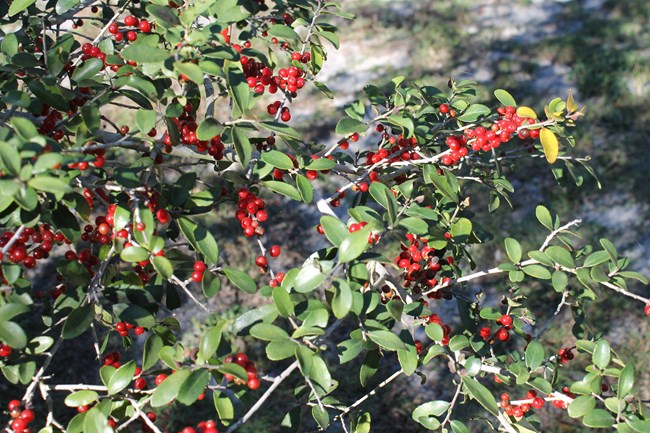
Yaupon holly is a shrub or small tree (it can reach up to 25 feet in height) with smooth, whiteish-gray bark that is found naturally from Virginia south to central Florida and west to Texas. It grows in sandy soils and is tolerant of salt spray and full sun, which makes it an ideal coastal species, but it also does well in shady environments, hence its prevalence along the nature trail. It is an evergreen plant with small, serrated leaves, and forms dense, shrubby thickets which are used by wildlife as nesting and roosting habitat. In the springtime small, white flowers bloom profusely and attract pollinating animals, especially bees. Being a dioecious species, male and female flowers are located on separate yaupon holly plants, so the female hollies (once pollinated) end up producing the abundant red berries that give the plants their distinctive appearance in the cooler months. Local and migrating birds (at least 28 species documented so far), as well as resident raccoons and squirrels, devour the berries, as they are an assured food source during the relatively lean winter months. While yaupon holly berries are packed with sugars that help sustain wildlife, its leaves contain something else altogether- caffeine! In fact, it has the highest caffeine content of any plant native to North America. Additionally, a type of molecular compound called polyphonols extracted from holly leaves were found to act as antioxidants, which are thought to help prevent chemical reactions in the body that can produce free radicals (negatively charged atoms or molecules suspected of inflicting damage on healthy cells). Native Americans (such as the Timucua, who inhabited northeast Florida at the time of European contact) drank a “tea” made from yaupon holly leaves and twigs for social and medicinal purposes. Men who wanted to ritualistically purify themselves apparently drank the tea in large quantities (and/or mixed it with other substances) to induce vomiting. When early European botanists learned of this practice, they labeled the tea “black drink” and gave the yaupon holly its scientific name, “Ilex vomitoria” (about as descriptive a scientific name as one can hope for). But the colonists themselves ended up following the natives’ lead and drank tea made from the holly as well, at least until imported tea from Europe and coffee became available and popular. Though sometimes it’s hard to see the forest for the trees (or vice versa), the next time you are visiting the park, walk the trail and keep an eye out for yaupon holly, a native Florida plant prized by humans and wildlife alike, and a welcome harbinger of Christmas in the South! |
Last updated: December 28, 2021
